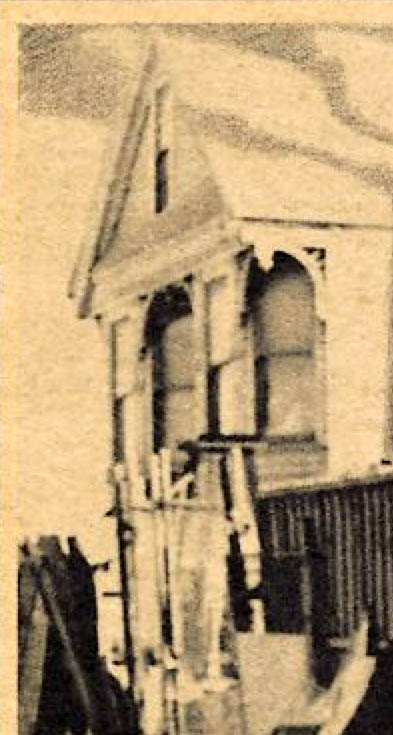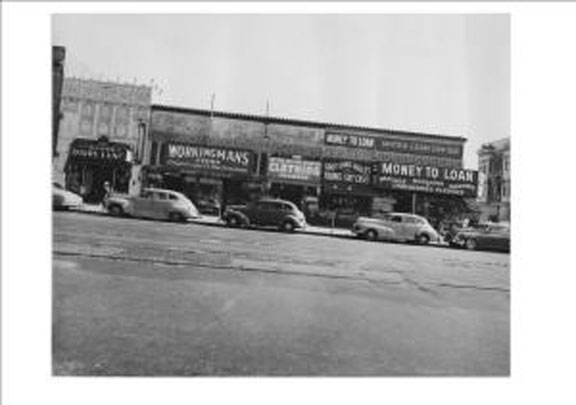 | ||||
 | ||||

|
The Grateful Dead - Workingman's Dead (1970) - Album Cover Location - 1199 Evans Avenue - Hunter's Point - San Francisco Workingman's Dead was recorded in February of 1970 and released on June 14, 1970 on the Warner Bros. label. It was recorded at Pacific High Recording Studio in San Francisco in just 9 days. (Wikipedia) It includes the songs, Uncle John's Band, High Time, Dire Wolf, New Speedway Boogie, Cumberland Blues, Black Peter, Easy Wind, and Casey Jones. Art credits are: Cover photo, art, and design: Mouse Studios, with Toon N Tree. (update) - Mouse Studios created many designs for the Grateful Dead. According to Wikipedia, Mouse Studios was created in 1959 by Mouse and his family as a mail order company. By the mid 60's its lead artists were Stanley "Mouse" Miller and Alton Kelly, whose creations were often credited to "Mouse & Kelly." According to Stanley Mouse, "Toon" was the nickname for Martin Gorak, an artist/magician from Detroit (a.k.a. "Martoon Master of the Mystic Poobah." "T" or "Tree" was Robert Tree. Mouse's recollection, is that during the creation of this particular cover, Kelly was in Boston." . The album cover. 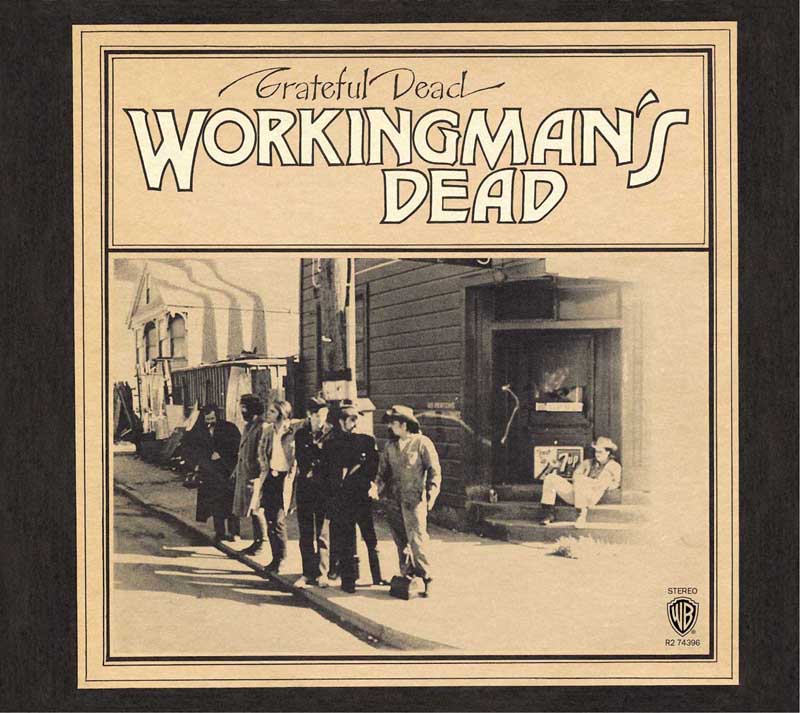
A contemporary view of where the album cover was taken from Google Street Views. 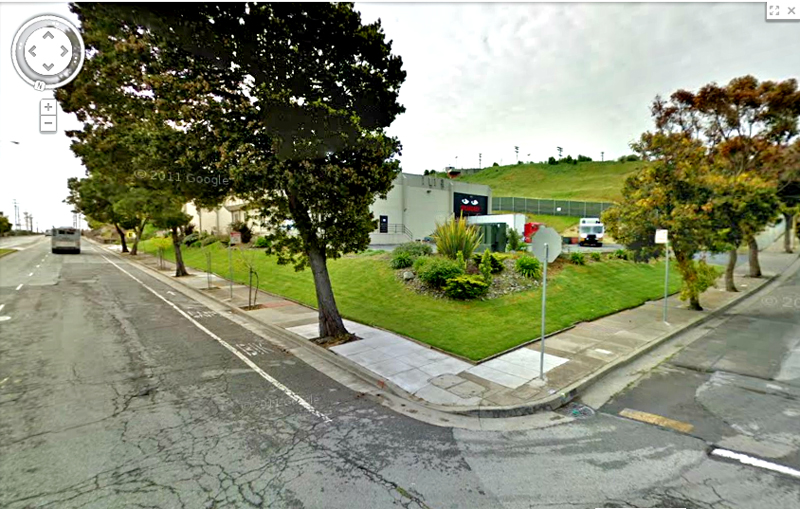
The album cover superimposed over the location. 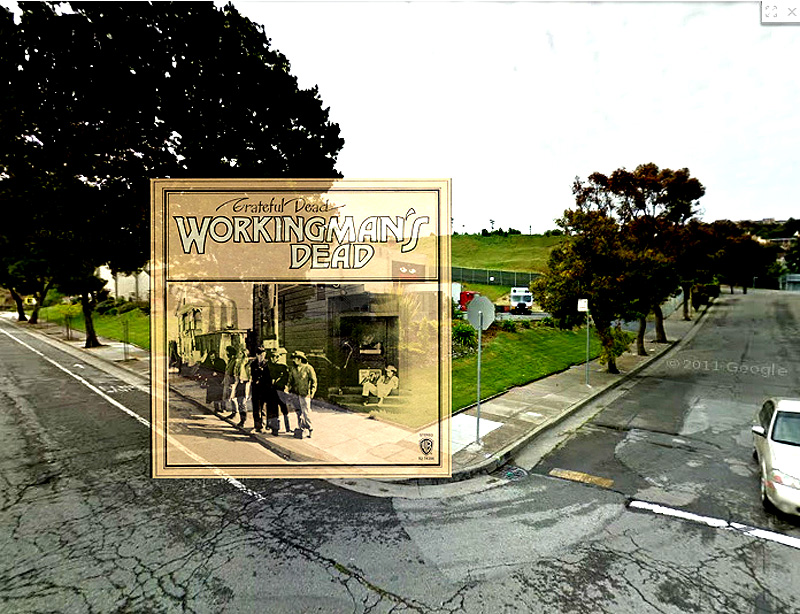
A composite shot to show you what the building might have looked like. That is a building from another part of San Francisco that looks like the "Workingman's Dead" building. 
A map showing the location of the album cover photo shoot. It's on 1199 Evans Avenue @ Keith Street, on the border between the areas known as Bayview and Hunters Point in southeastern San Francisco. 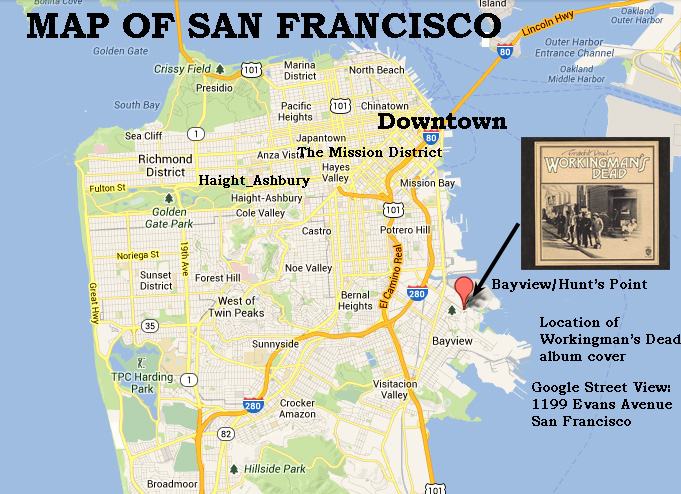
How two fellow researchers, Jonathan Lammers, a San Francisco architectural historian and Brad Thompson (Twitter handle: PASTMAPPER), a San Franciscan map historian/researcher who saw Lammers' tweets about the project, and I discovered the site after a year long search. Let's start with a close-up of the front cover photo. In the photo we see, left to right, Robert Hunter (lyricist), Jerry Garcia (guitar, pedal steel, vocals), Bob Weir (guitar, vocals), Phil Lesh (bass, vocals), Mickey Hart (drums)... 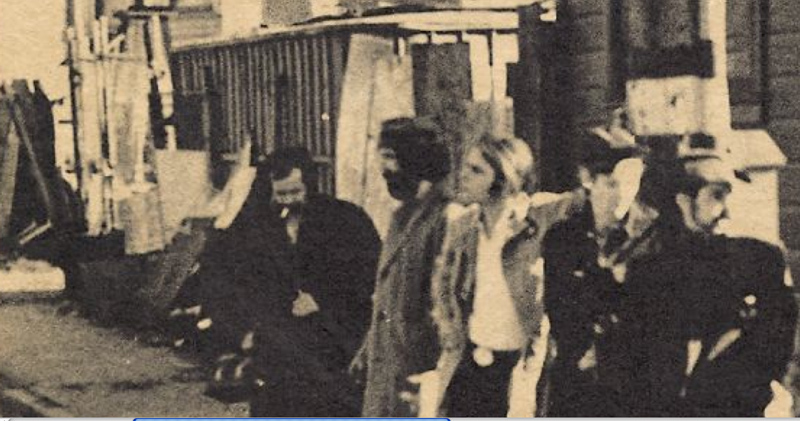
...then Ron "Pigpen" McKernan (keyboards, harmonica, vocals) and in the doorway, chillin', Bill Kreutzmann (drums). 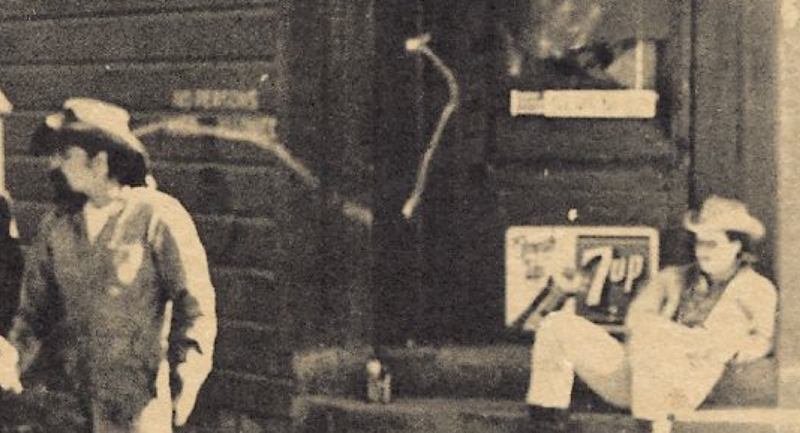
The album cover shot really has an old-timey feel of the American past to it: To go with the album's title, the photographer(s) took a photo of the Dead as seven factory workers at a streetcorner, most likely waiting for the bus back from work. 
One has a lunchbox. Another is lying down, getting out the the sun, definitely not posing. In the background smoking smokestacks imply the setting is an industrial area. The soft focus, black-and-white shot looks like it was taken candidly with an everyday family camera. Here's the era they were trying to capture. 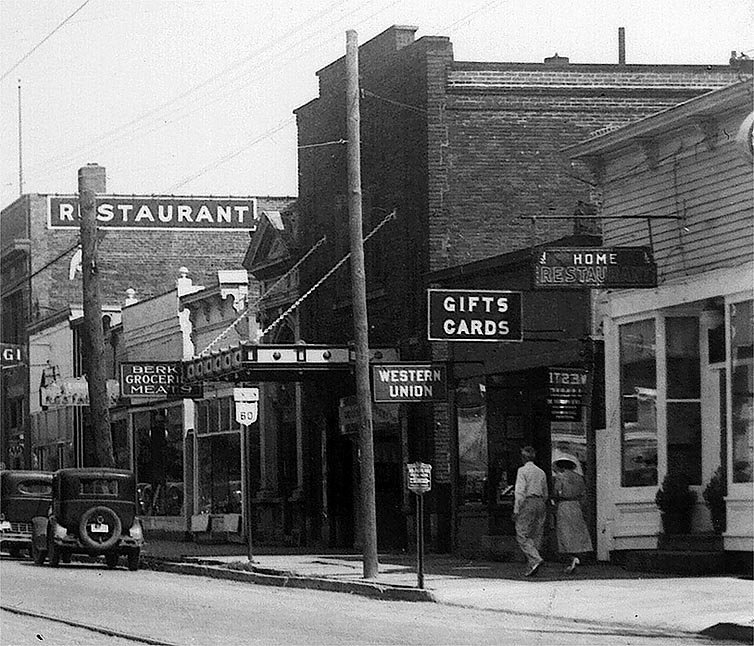
So to find the location, I began to look for specific clues. One of the first things many people notice are the three smoke stacks in the back of the photo. 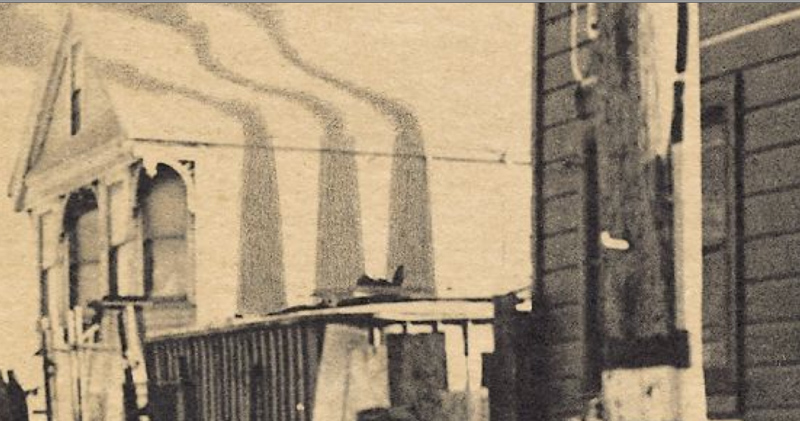
And rising from them are three plumes of smoke, seen against the roof of the Victorian-style house (later I would find out the specific style is called "Queen Anne".) There were many references among Deadheads online as to the smokestacks and smoke having been drawn in to add to the "workingman" neighborhood feeling of the picture, so they aren't actual clues, except to maybe to indicate the photo was taken an industrial area. The artist painted them with a wink to the viewer: Notice how the shadow of the plume of smoke on the left, doesn't just cast a shadow on the roof, but it continues to cast a shadow in the sky beyond, too. .
It was also common Deadhead knowledge that one of the artists originally drew in a large cartoon version of a "star nosed mole" (see picture) in the background, but the Dead asked him to remove it. You can see it in this photo to the right of the smokestacks. 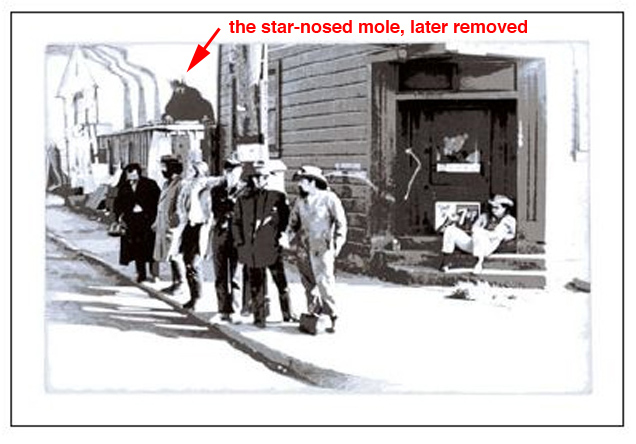
What a real star-nosed mole looks like (from Tumbler). 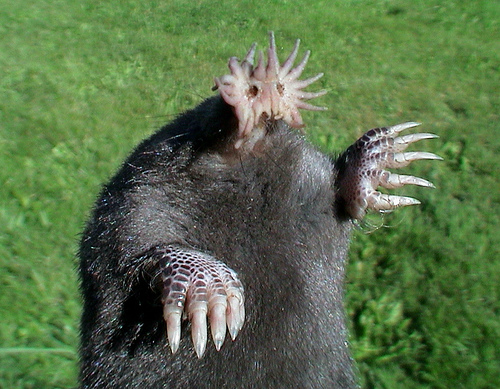
Another clue I looked at was the Victorian house in the background. It had one window on the top and two protruding bays on the second floor. More on this later. The photo on the left is of a random Victorian in San Francisco, just to illustrate the bay window. 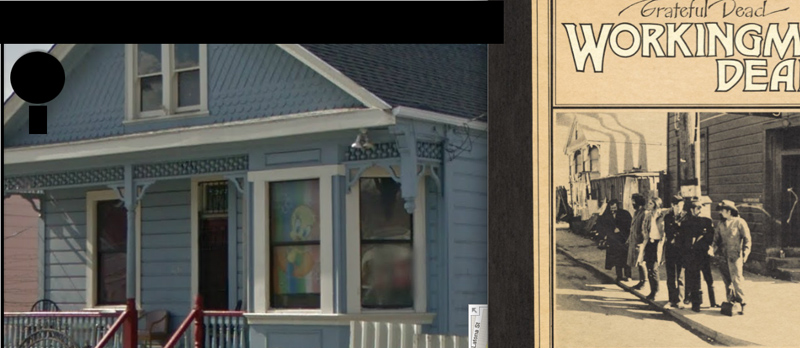
Another clue was the circle at then end of the sign. Was it the bottom of a small "g" or an "o" like this sign for a new York bar? 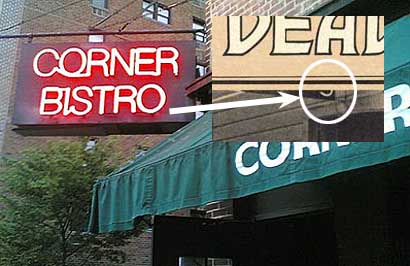
Finally the other clue that came just from looking at the photo was the direction of the sun. If the sun was coming from this direction, and the sun usually shines from a southerly direction in America, south would be to the right. 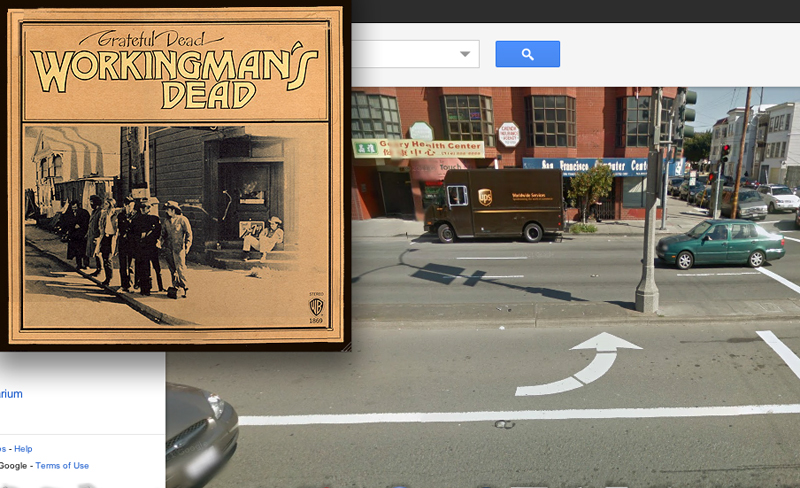
Now that I had looked at the cover for clues, I searched on the web for more information. I started by searching for anything related to the cover by the artists named on the cover: Mouse Studios (along with Toon N T.) The main artists for Mouse Studios, often referred to together as "Mouse & Kelly," were Stanley "Mouse" Miller and Alton Kelly. They are legends in the San Francisco rock world, having created the Grateful Dead logo and many of their album covers. They helped to create and define the 60's San Franciscan music scene with their distinctive posters, many a combination of Art Nouveau and psychedelia, which they made for hundreds of shows at San Francisco rock halls like The Fillmore West and the Avalon Ballroom. 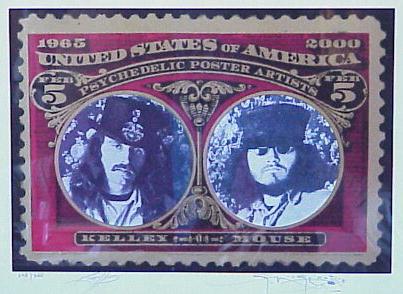
They also did album covers for bands such as Steve Miller and later, Journey. You can find out more about them on Wikipedia and you can purchase their artwork at many outlets on the web.). Alton Kelly died at age 67 in 2008. Mouse (Stanley Miller) has a website at: www.mousestudios.com .
One of the the Grateful Dead logos created by Mouse & Kelly. 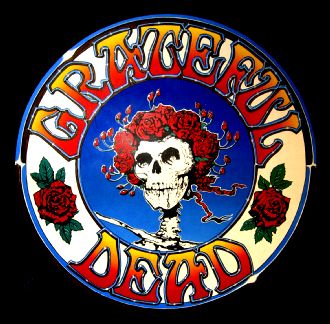
In searching for background about the photoshoot using Mouse and Kelly's names, I found two similar versions about the shoot, with some minor differences: One version has Kelly bringing them to the "Mission District" and taking their photo with an old Brownie camera. The other version has Mouse dressing them in work overalls on a hot 104-degree day, and posing them in front of "the old Barney's Beanery...across the street from a meat rendering plant." This version seems to indicate that Mouse took the photo with a Brownie camera to make it slightly out-of-focus." So bottom-line-wise for my research: it sounded like Mouse and Kelly were both at the shoot, one of them took the picture with a Brownie camera, and the photoshoot was either "in the Mission District" (Kelly), and/or "across from a meat rendering plant" and in front of a place called "Barney's Beanery (Mouse)* So those are the clues I went looking for. But first, read the two similar narratives about the shoot that are found in books and on the web, for yourself. The "Kelly" narrative 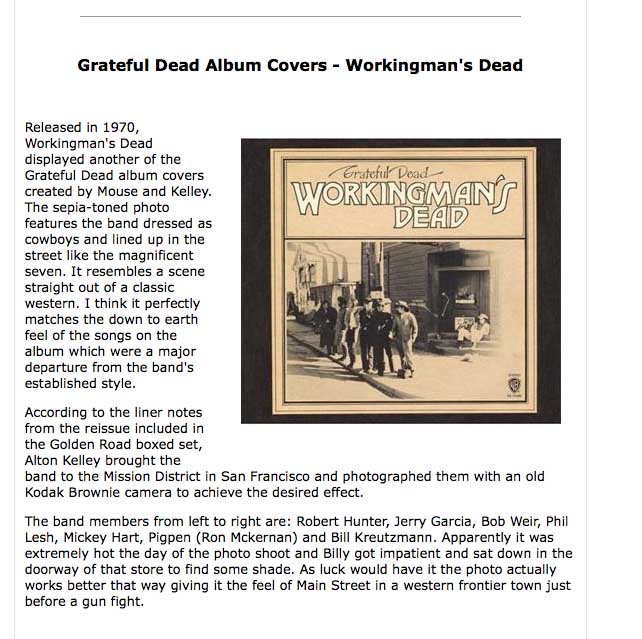
The "Mouse" narrative 
FYI: A Brownie camera circa 1968. 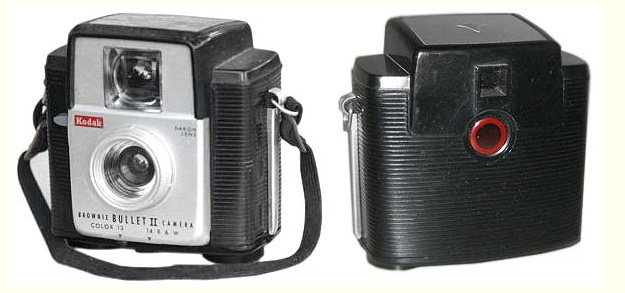
Alton Kelly had died in 2008, so I emailed the Mouse Studios in California to see if I could get any further information as to the location from Stanley Mouse. Stanley's assistant, Christine, reponded to my email and said she asked Mouse for me and "he says: Yes the photo was taken in front of the Barney's Beanery restaurant in San Francisco. But he doesn't know the cross streets." She also sent me a link to a blog which she thought might be helpful in my search. Someone had sent her the link. It's a photo of the logo of an old shoe store in Oakland, across the bay from San Francisco, with a typeface similar to that of "Workingman's Dead." Whether it is the basis of the logo, I don't know (and I think not) , Christine didn't say, but it conveys the same feeling as the album and looks pretty retro/cool. (To read more about it cut and paste this:
http://ameliamarshall.wordpress.com/2011/06/01/the-workingmans-stores/ )
Next, I decided to follow the clue that had been written about in the Stanley Mouse auction piece and which he also concurred via his assistant: that the picture was taken in front of a restaurant called Barney's Beanery. There has a famous restaurant named Barney's Beanery in Los Angeles near the Sunset Strip since before the 60's. There's even a picture of it on "Cheap Thrills" by Big Brother & the Holding Company (the band Janis Joplin was lead singer for). You can see it on the lower right of the central circle on this picture of the album cover. 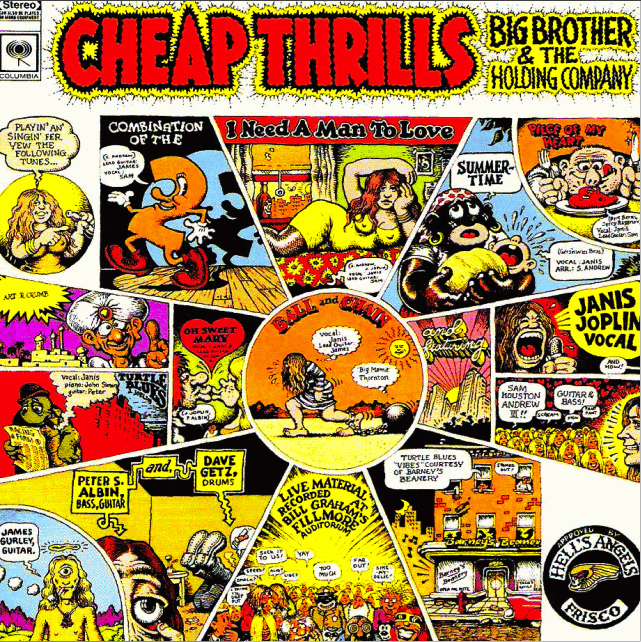
And here it is in a close-up. You can see where R. Crumb, the artist, writes "Turtle Blues "vibes" courtesy of Barney's Beanery." Janis took a tape recorder to the restaurant and taped some people talking as background for the track called "Turtle Blues." 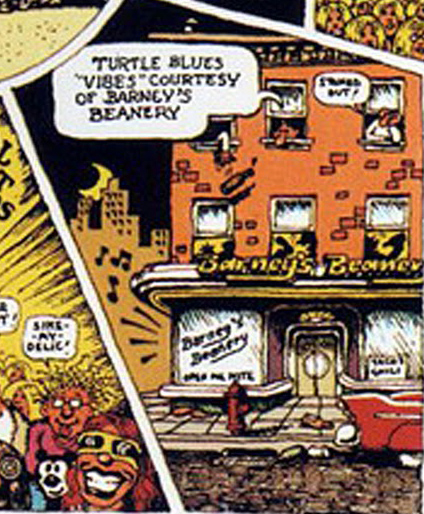
So I called up Barney's Beanery in L.A. I spoke to Jeremy Maine who works there and asked him if there was any connection between Barney's and the Grateful Dead photo in San Francisco, and he said none that he knew of. He said there was had been no other offshoot of the L.A. Barney's Beanery in San Francisco, except that, long ago, the restaurant had originated in 1920 outside the Sather Gate on Telegraph Avenue in Berkeley. This is a photo of Barney's Beanery on Santa Monica Boulevard in West Hollywood, California. It was the fabled hang-out of Hollywood stars like Clark Gable and Errol Flynn, as well as 60's rock stars like Jim Morrison and Janis Joplin (who was supposedly had drinks there the night of her death a few miles away. Wikipedia). 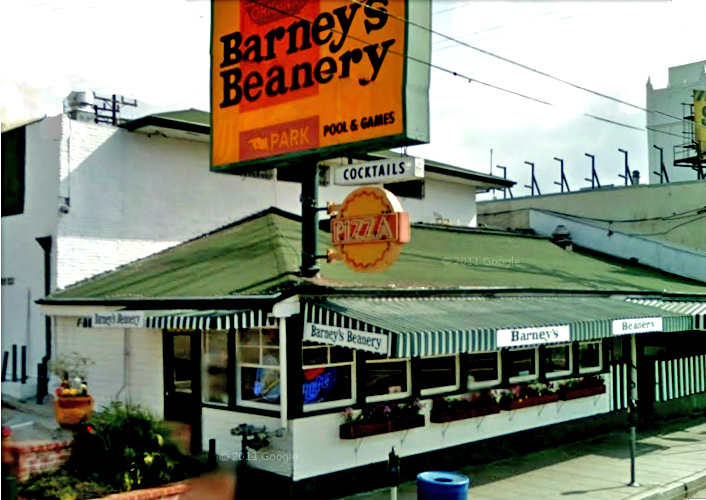
I later spoke with Jon Underhill, a local Berkeley, California, historian and he said there was no reference to a Barney's Beanery in Berkeley (good tongue twister!) or Oakland either in any of the old phone books. So the Barney's clue was not panning out for me either. Next up: To see if the back of the album held any clues. Here's the back cover of the album. Unlike the front, the back is missing the photo of lyricist Robert Hunter (supposedly, much to his chagrin.) The photos were taken by Stanley Mouse who then touched them up to look painterly. (Note: see ADDENDUM #1; they are actually charcoal, ink, pencil, and airbrush on paper). 
I figured that maybe they were taken on the same day as the front cover shot, since two of the guys had the same cowboy hats on they had in the cover photo. So, if I could figure out where the back cover location were taken, it might lead me to the front cover location. I found the original photos on a variety of Dead websites. Here they are: Pigpen - 1 (a note says the photo was taken on June, 14, 1970) 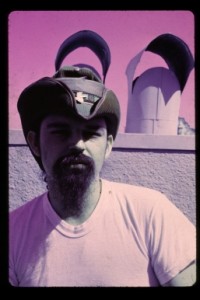
Pigpen - 2 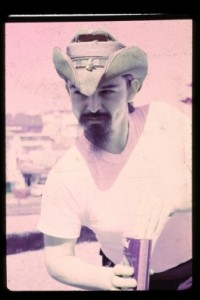
Pigpen - 3 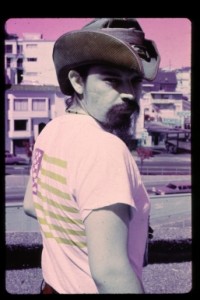
Micky Hart 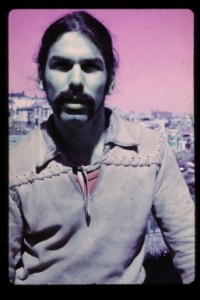
Bill Kreurtzmann 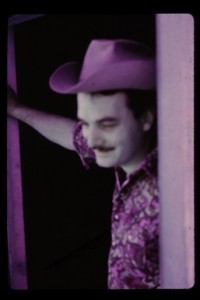
Robert Hunter - 2 (notice the background - I will refer to it in a minute) (This photo was not depicted on the back cover.) 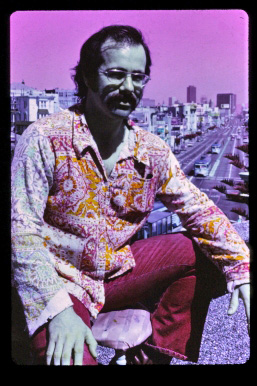
Phil Lesh (notice the background - I will refer to this, too) 
Jerry Garcia (note: I added this after I wrote the entry. I forget who sent it to me (please write in). According to Mouse (see addendum), the deck he photographed the band on was next to his attic. Jerry was photographed in the attic. Bill Kreurtzmann, (see photo above) was walking out the attic door. 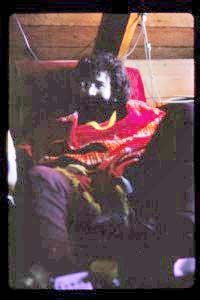
This is a composite of the backgrounds from the Hunter photo and the Lesh photo. 
This is a photo of the tall black building in the background. 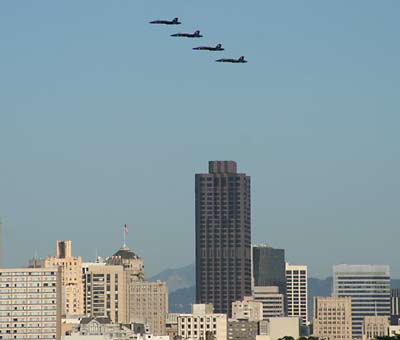
Using these two photos as reference, with the help of Allison from the San Francisco Streetcar Museum, I was able to figure that the photos were taken where the "X" is on on the top of this building at the corner of Castro Street and Market Street below. (note: (update) Actually, in correspondence with Mouse, I learned that they were photographed about 50 feet to the left of the "x," on the roofdeck of Mouse's apartment, which has been replaced by the modern apartment building with two flat roofs, that you see just to the left of the building with the "x." (I will add more on this in a future addendum.) 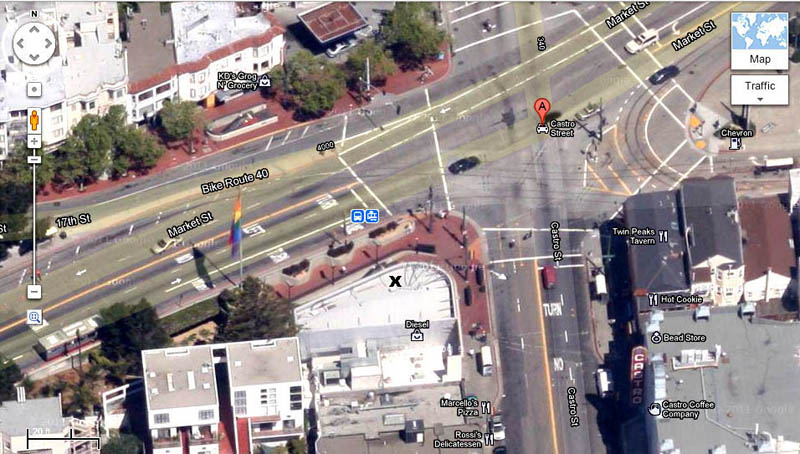
Here is that building at the corner of Castro and Market from another angle. 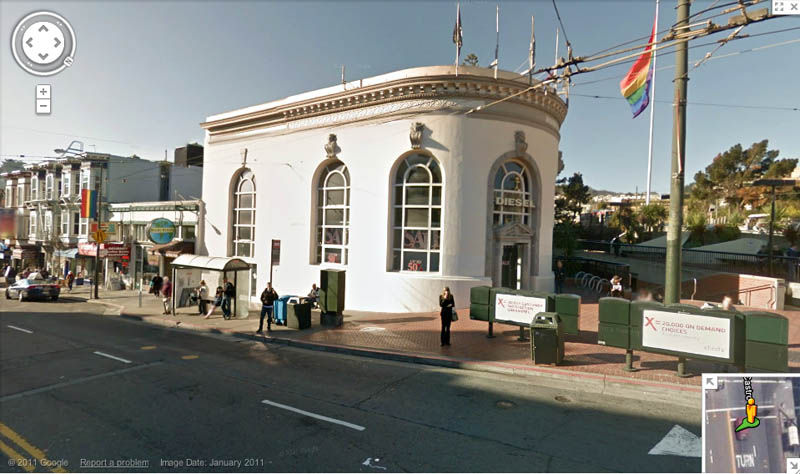
I was hoping that the photo would have been taken in the Mission District where Alton Kelly had said the cover photo was taken, but as you can see from the map below, it was about 1/4 mile west of the Mission District, so it didn't even seem like walking distance to the other photo. Thus, the back cover photos didn't provide me with any new clues. So...on to the Mission District! 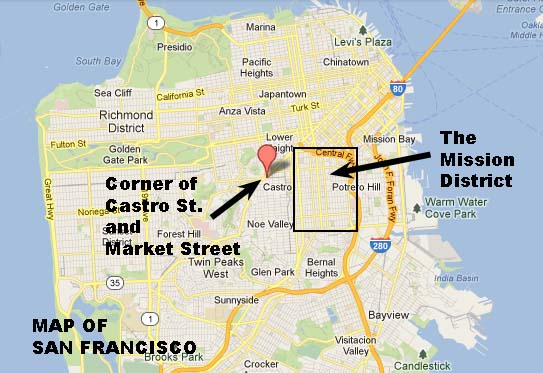
The next place to focus my search was on the Mission District, where Kelly said the photo had been taken. The Mission District (commonly called "The Mission") is a funky, multi-ethnic, bohemian section of town about a mile square, so I figured that using Bing Bird's Eye View Maps, I could "fly" over the streets and look down to see a combination of a) Angled Corner with three Steps and b) Queen Anne house with one upper window. Below is an example of what I was looking for -- though it's one that didn't match up. 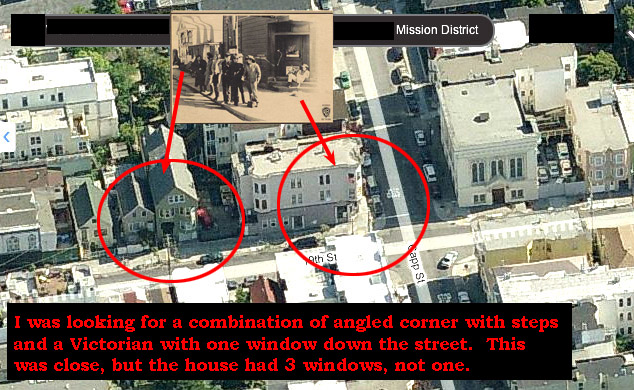
At this time I also got in contact with a architectural historian in San Francisco who I found through a Google search. The expert I found, Jonathan Lammers, who also gave tours of San Francisco's Victorian house and other architecture would ultimately prove to be one of the two key partners in the search (more on this later). Here's how I found him online: 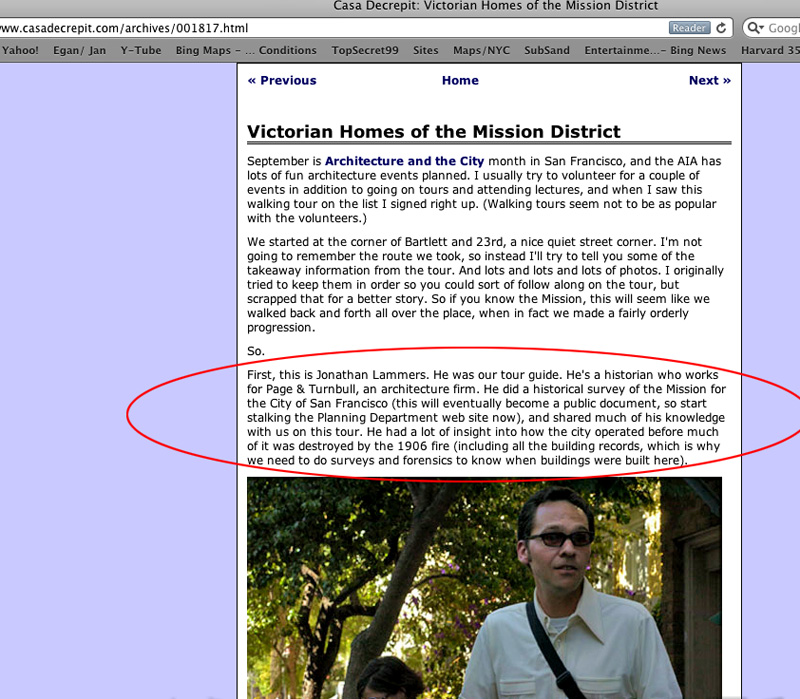
For now, Jonathan advised me on the different types of Victorians there were (such as second Empire, Queen Anne and Stick style), including their window look and decorative trim, and where a building like the one-window Queen Anne I was looking for might be found, since many buildings in San Francisco had been destroyed in the famous San Francisco earthquake of 1906. For example, he advised me that since the Queen Anne style houses were built between 1895-1905, and the earthquake came after that; that the area of the photoshoot would not include any area destroyed by the earthquake and subsequent fire, since the white Queen Anne behind the Dead had survived until at least 1970 when the photo was taken. He also was very informative about using the San Francisco Public Library digital files, as well as other San Francisco online resources, both of which would later come in handy. With Jonathan's info, I set out to look for one-windowed Queen Annes in the Mission District. But before I did that, I called the San Francisco Streetcar Museum to request a bus map of San Francisco in 1969. Why? Well, in the cover photo it looked like the Dead were standing at a bus stop. So I figured I could save time just by looking at the streets where busses went through the Mission District. A very helpful woman named Allison found one for me and $10 later plus postage it was on my desk. 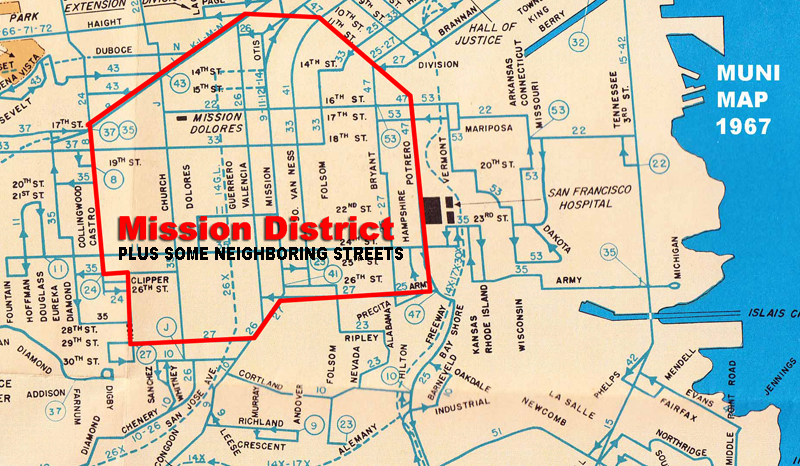
So I mapped out the roads to the Mission - and a few roads around it - and "flew" over the buildings while eating my lunch for one week. No score. When that didn't pan out, I used Google Street Views and "walked" all along the bus routes, looking for the combination "3 steps/Queen Anne house." Here are some I found: This one had a pretty good looking doorstep.... 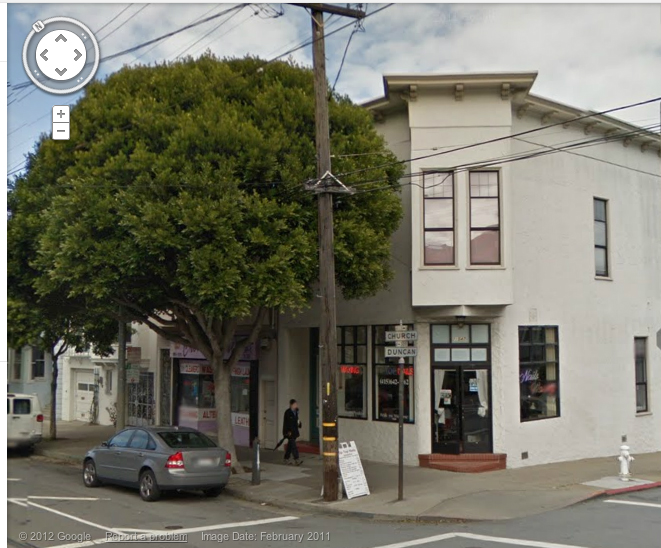
as did this one... 
This building was a mess but had a nice look, but the steps weren't high enough 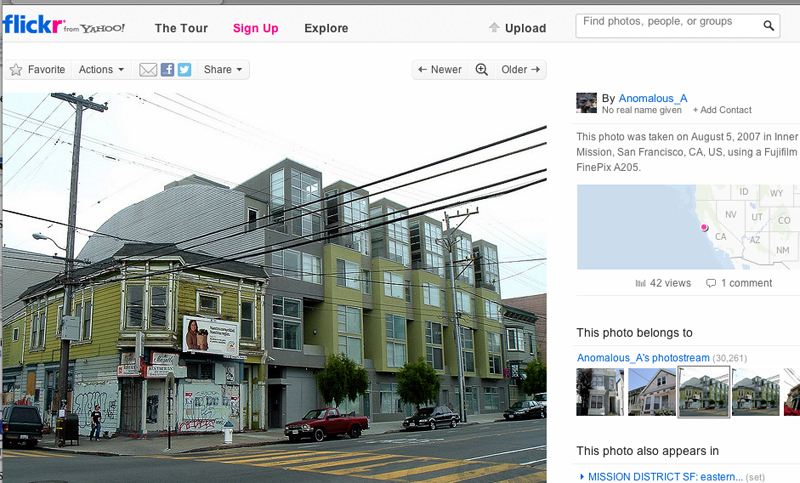
This one seems to have the corner AND the Victorian look, but it was the wrong style of Victorian. 
I LOVED this building and thought I had it. I thought maybe the steps had been moved inside. The side of the store seemed to be the right size, too 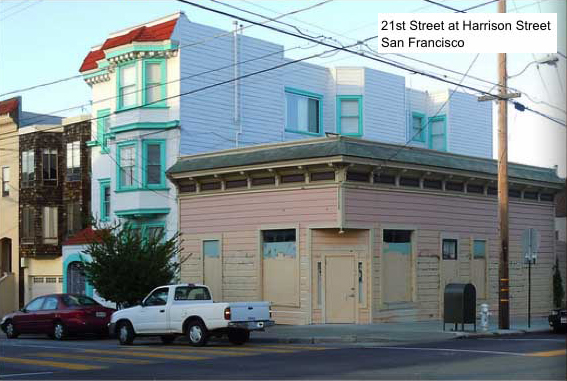
I had found this through FLickr. 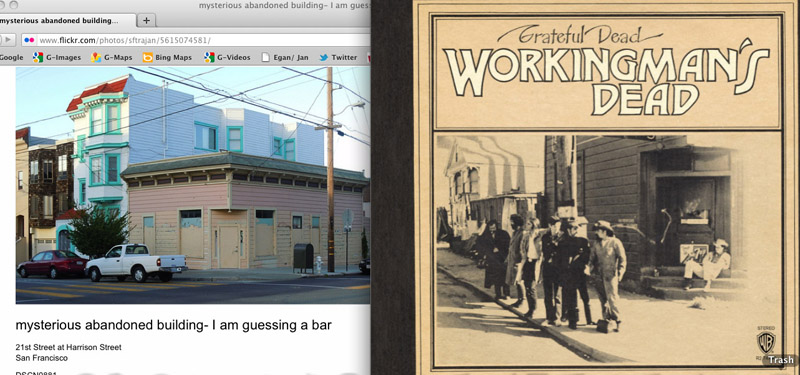
It's the one I used early on to show what the shape of the building might have been like. 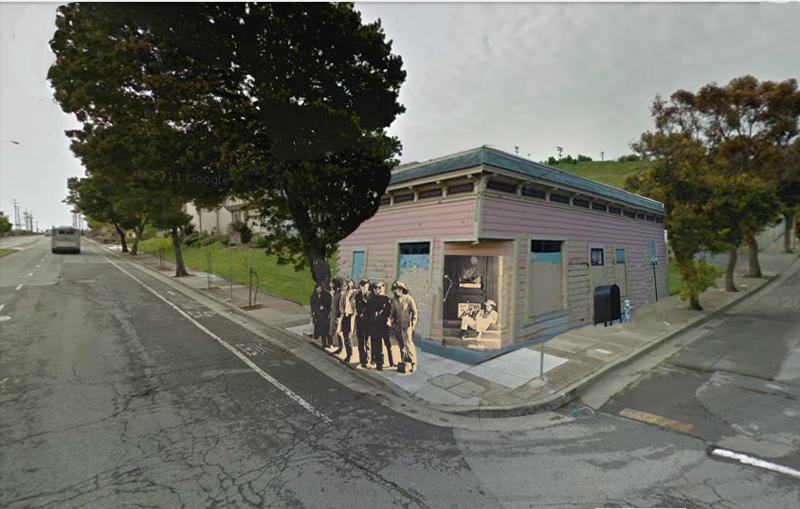
But ultimately it didn't fit. But at least I can give the guy napping down the block a few moments of fame. 
So once more I had struck a dead end. Where next? To the Slaughterhouses!! In the Stanly Mouse description of the photo session, he indicated that the Dead were across from a meat rendering plant; and since it smelled so bad - that's why the Dead all look so disgruntled out on the street corner. So after Googling "slaughterhouse and Mission District" and finding nothing, I found an expert on San Francisco slaughterhouses named Conor Casey to sound him out. 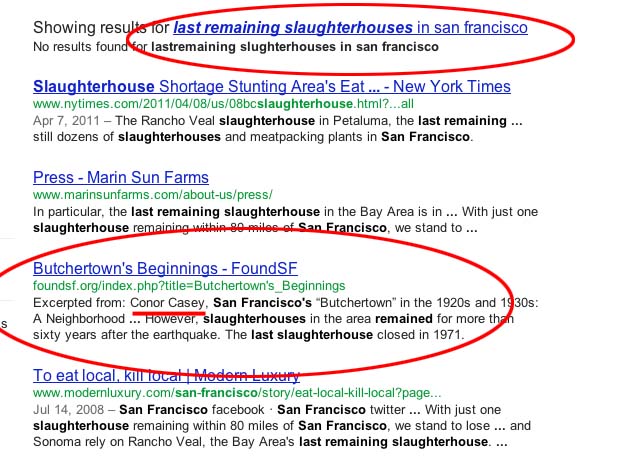
Here he is. He had written an article called "San Francisco's Butchertown" which I had read online. 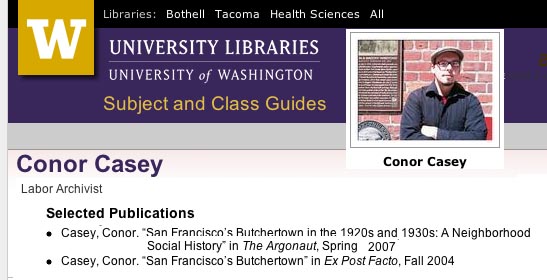
This photo came from his article from 1921. Little did I know that the the Workingman's Dead album cover photo was taken on Evans Street about a mile down from the road from this photo. . 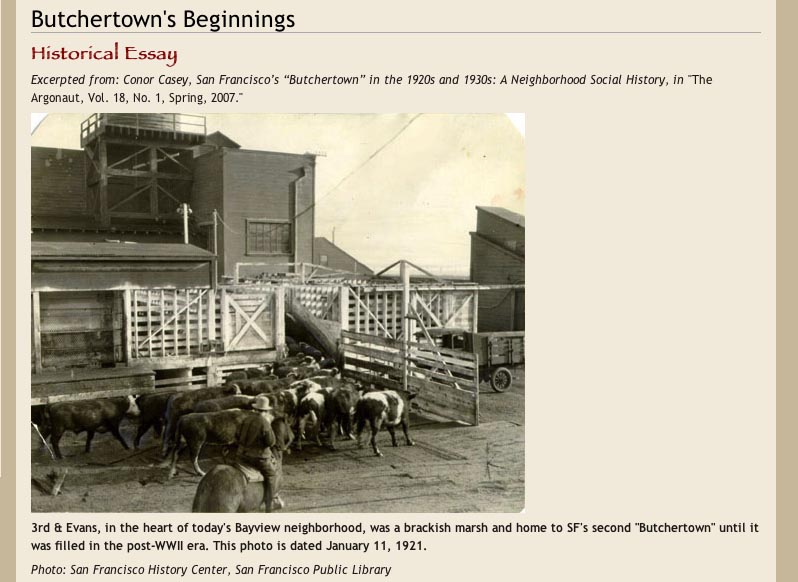
With Conor's help I marked out the area where the last remaining slughterhouses were in San Francisco at about the time of the photo shoot. None were near the Mission District. 
They were in Bayview and Hunters Point, which were several miles southeast of the bottom of the Mission District where the shot supposedly was taken. 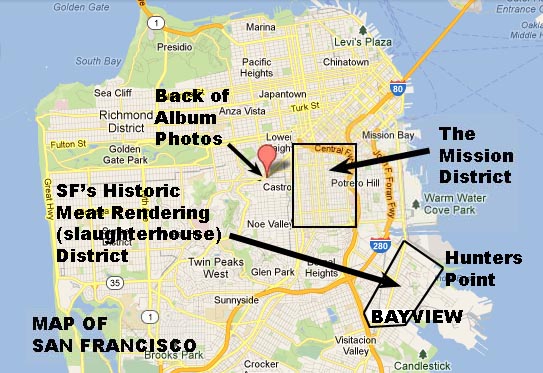
So I was at another dead end. What to do? Answer: Do different PopSpots while I regroup my thoughts. So I did. Then - FLASH FORWARD ALMOST EXACTLY ONE YEAR LATER TO THE DATE. Out of the blue, I get an email from Jonathan Lammers, the San Francisco-based architectural historian who I had been working with at the beginning of the search. The email was entitled: Workingman's Dead Cover Location found. It included several pictures. Here are the the pictures followed by the email. 
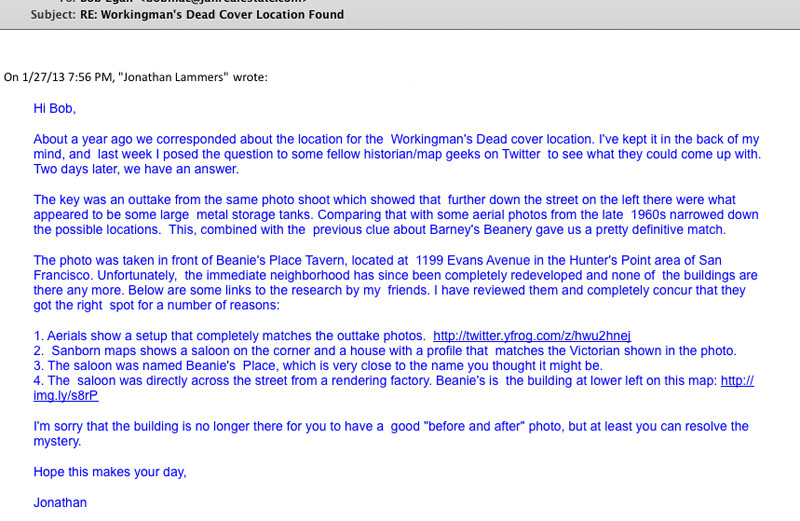
Well, to say the least, it did "Make my day" - as another famous San Franciscan once said. So I hurredly opened his photos to see what he and one of his fellow San Franciscan Twitter / map afficianatos had come up with. It turned out to be an outtake from the Workingman's Dead photoshoot. It had been found by Brad Thompson, whose Twitter handle was PASTMAPPER.
Looking at the outtake, at first glance you see a dog in the picture, as well as another person on the steps. But in the background, looming large on the left, are two huge oil tanks. 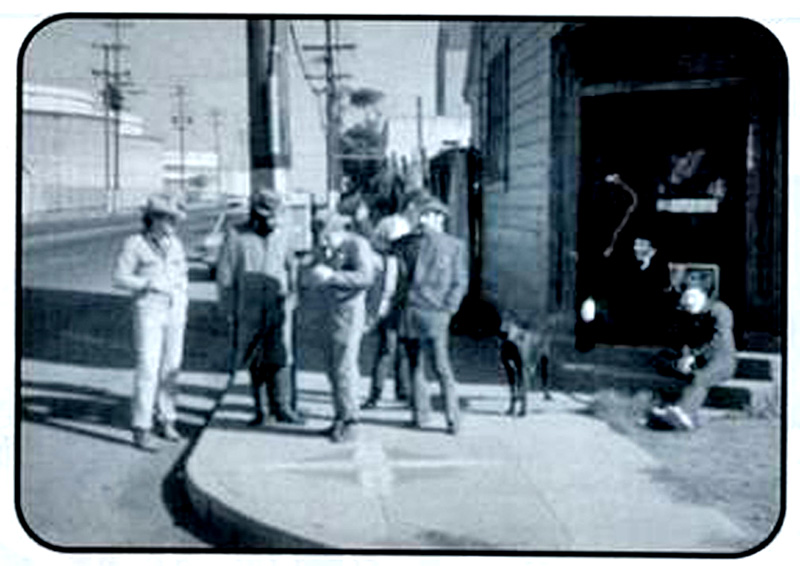
So, using Google Image's "seach-by-image" I tracked down the new CD booklet that the photo had come from. It was this (note: I found out later: it's from a 2001 Grateful Dead box set called "The Golden Road" - see addendum) 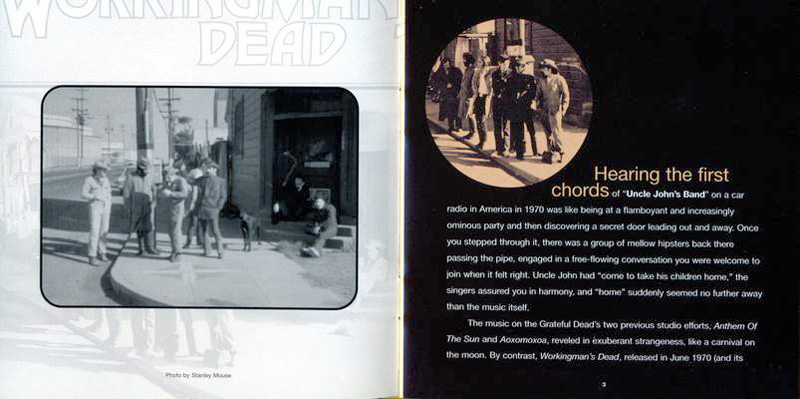
Here's another inside page. 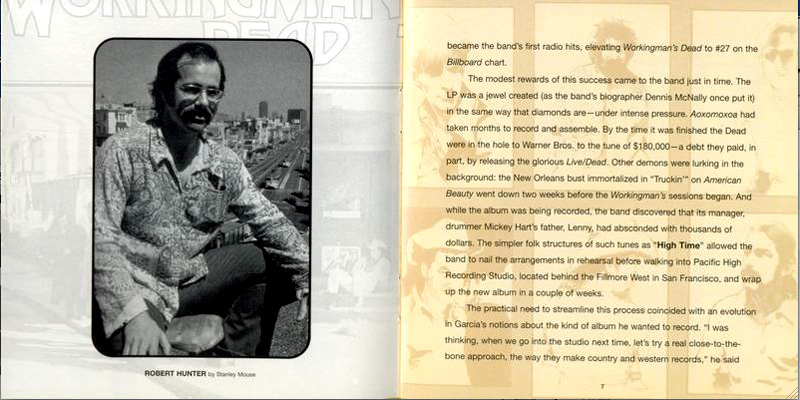
And another. 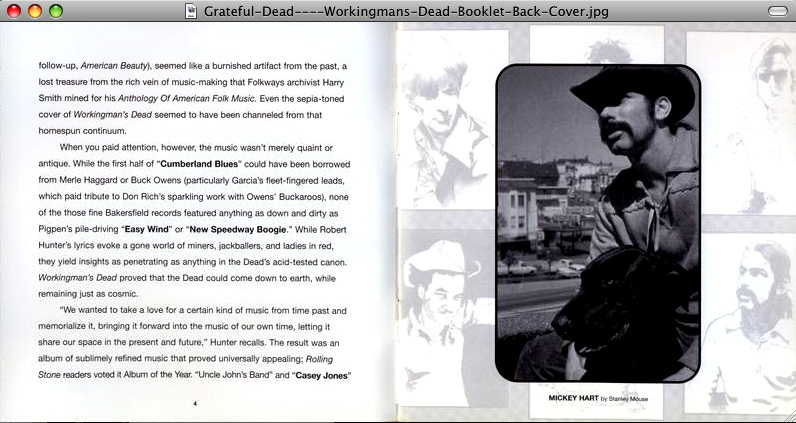
Jonathan told me I could find the address of the tavern the Dead were in front of at a website called SFgenealogy.com which has phone directory from 1963. Notice in the circle below that it says "Beanie's Place Tavern" at 1199 Evans Avenue. That's the building. So it wasn't Barney's Beanery after all, but rather Beanie's Place Tavern. Well, the name was close. And notice what's across the street at number 1198...The H Moffat Company meat packaging plant, as well as the Union Products Company rendering company. So there really had been a smell that was upsetting the band.!And, the building was in the slaughterhouse district triangle that Conor Casey and I had come up with. 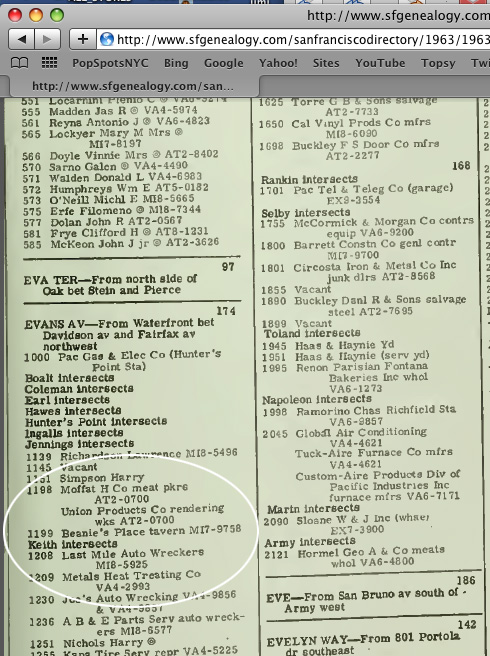
Now it was time to try to find a picture of the tavern - which we know now was Beanie's Place; (which meant that the little curve on on the bottom of the sign out front that we saw at the beginning of the search could have been the bottom of the final "e" in "Place.") So we (Lammers, PASTMAPPER (Brad Thompson), and crew) looked at a site which has historic ariel views of San Francisco called the David Rumsey Map Collection and found the location of the gas tanks. (David Rumsey posts historic maps online). 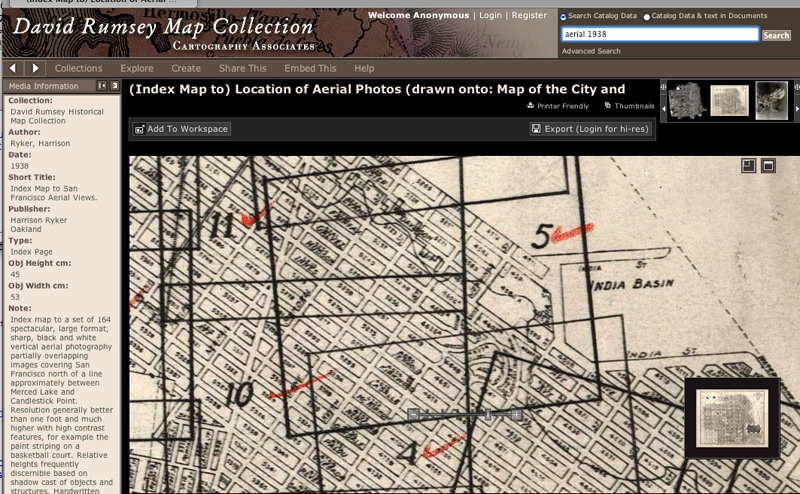
The overall map of the Bayview/Hunters Point area looks like this. I've circled the area around Beanie's Place. 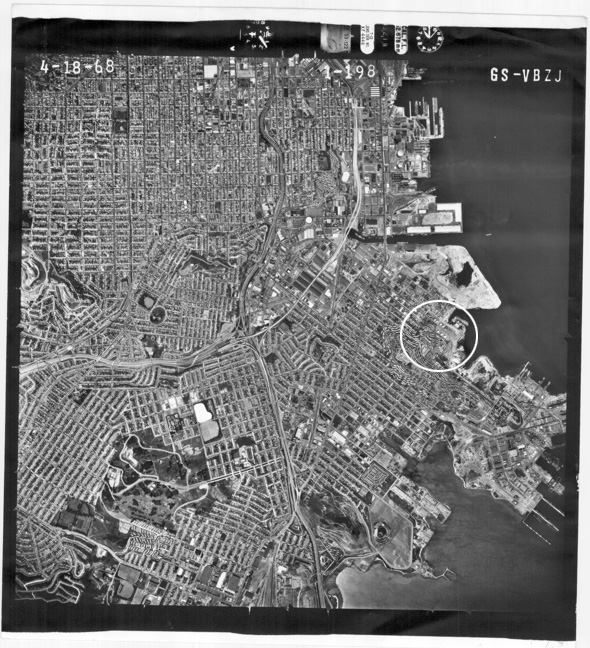
(The aerial photo was taken in 1968 by the United States Geological Survey and can be found online at the University of California at Berkeley Library (frame 1-199) Getting closer, you can see the four oil tanks that are in the background of the newly found Workingman's Dead outtake. 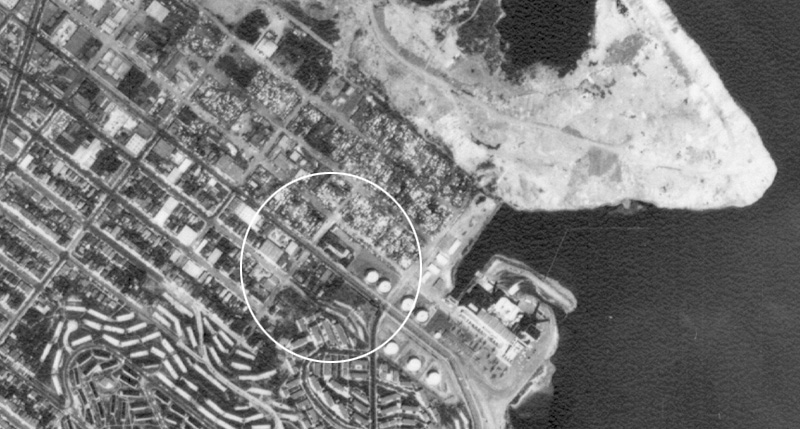
This is a copy of the "Sanborn" map that Jonathan and PASTMAPPER (Brad Thompson) were referring to. Once they found the tanks, they found the street with this Sanborn "fire insurance map" and found the "Dead" bar on the bottom left hand corner. Then, once they had the street number - 1199 Evans Avenue - they looked it up in an old San Francico city directory (somewhat like an old "reverse phone book" where you search by address) to get the name of the business in it: Beanie's Place. 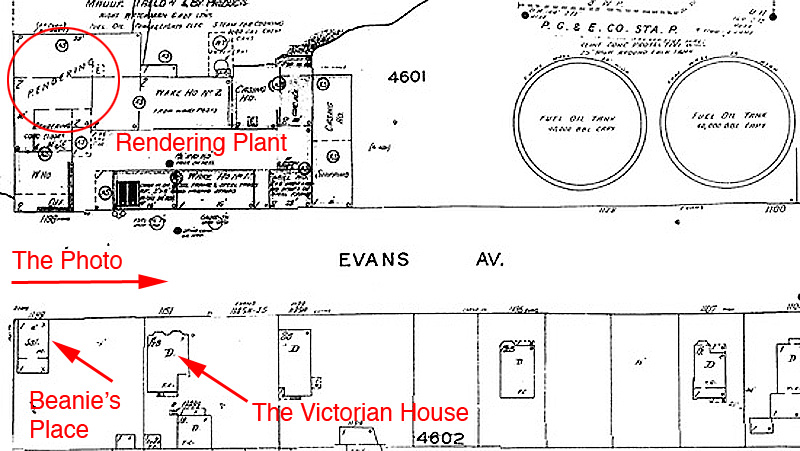
Zooming into the overhead shot, here we match up the two Beanie's Places, one from the photo, one from the Sanborn map. 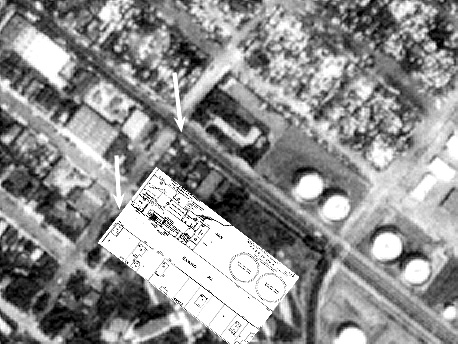
Here's a close-up. You can even see a shadow of the telephone pole the Dead were leaning on jutting into the street just above the tavern. Just above the Victorian house to the tavern's right, you can see there was a large tree back in this 1968 photo. That would have been just out of camera in the cover shot. 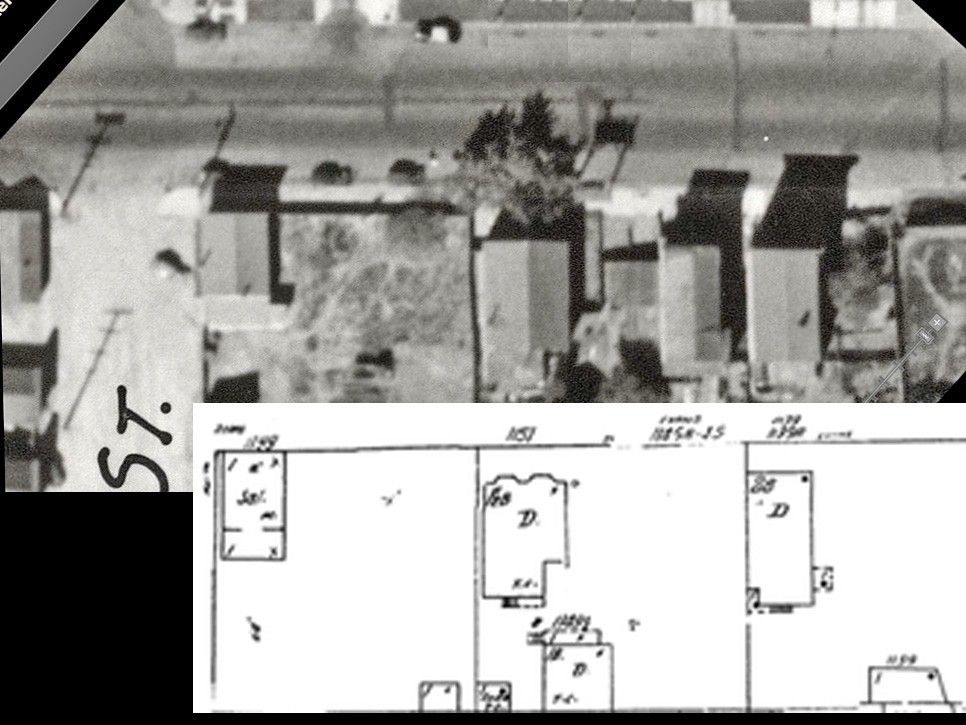
Here's another look. 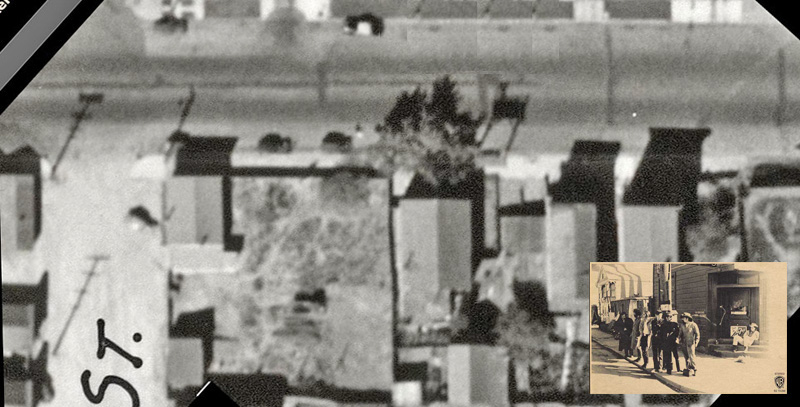
For the time being, that's as close to another shot of the tavern that I could get, other than one one on the new cd cover. I am hoping another picture will pop up in much the same was as the Lammers/PASTMAPPER information showed up a year later. We've looked at San Francisco property website for the Evans Avenue address...
...and also from the Keith Street side address. 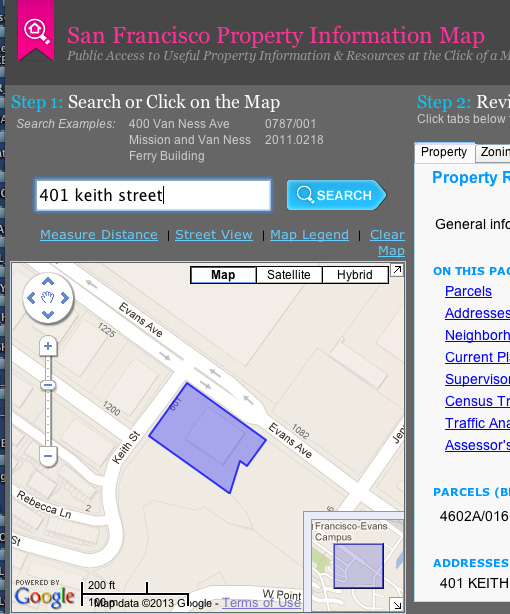
We did find these two photos taken right next to Beanie's. This 1964 picture from the San Francisco Library shows the intersection of Evans Avenue and Keith Street, looking north. Beanie's Place would be just to the right of those cars in back of the truck on the right. And further back, on the right hand side, across the street, is the side of the famous rendering plant. 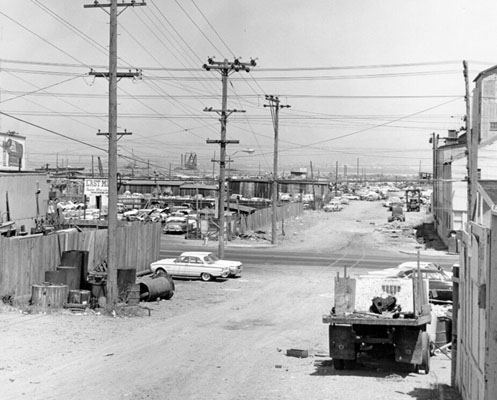
We also found this photo is taken just a little way up Keith Street from Beanie's Place (which would be to the left) looking across Fairfax Place. 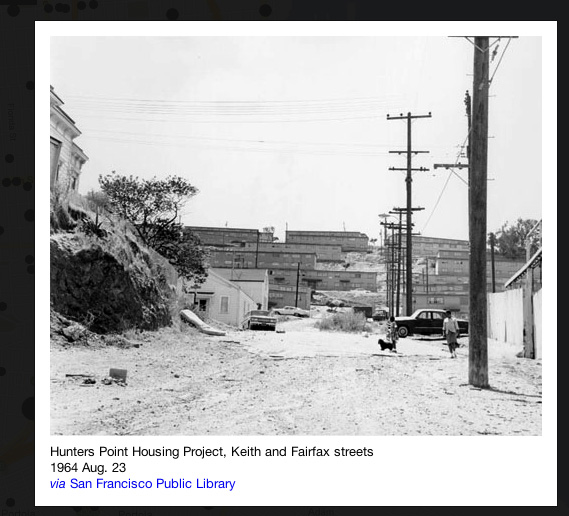
Evans Avenue has completely changed since the Dead had their picture taken there. Here's Beanie's Place in 1968, two years before the picture was taken. 
By 1980 the entire area had been leveled except for the Queen Anne house and the gas tanks. 
And by 2004 an entire new neighborhood had been built upon the area (although you can still see the outline of where the two oil tanks used to be. 
It's been a proverbial "long, strange trip" for this neighborhood 'till today. 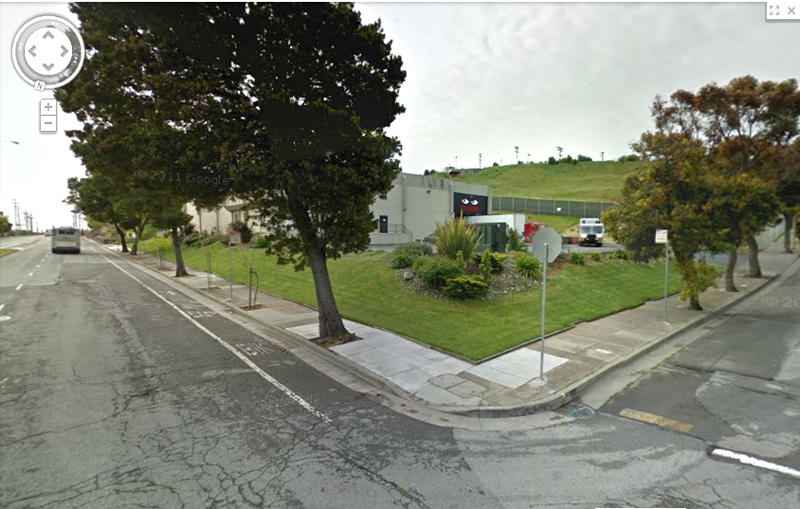
But for one brief, shining, Brownie-recorded moment in 1970, it became a legendary backdrop to a legendary band.nick 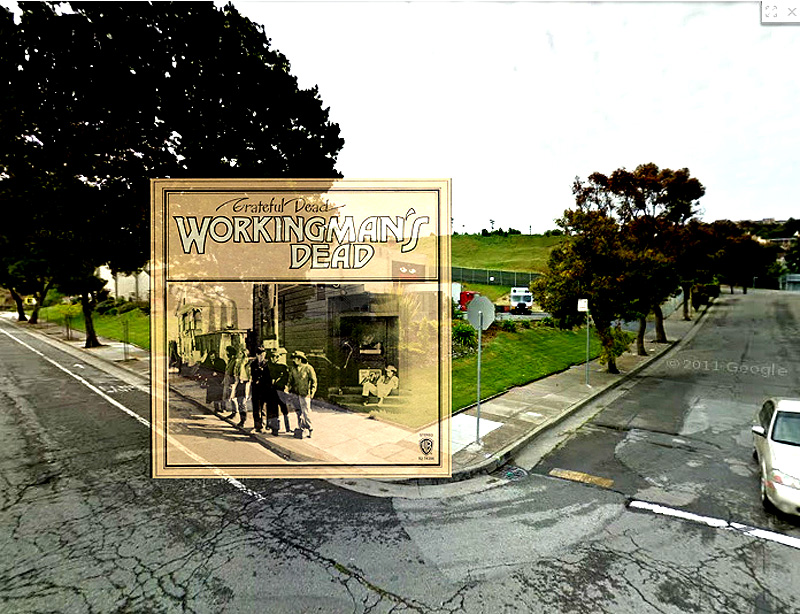
For ADDENDUMS to this entry, look below the THE END image. 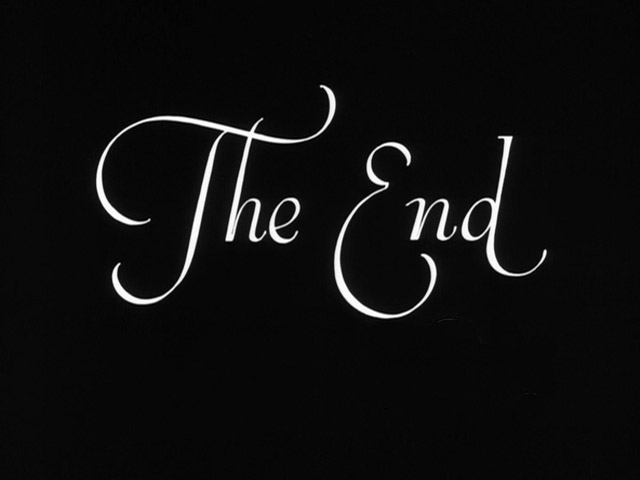
ADDENDUM #1 Re; The album back cover illustrations Hi Bob, ADDENDUM #2 Stanley Mouse writes to PopSpots that he took the photo with a Leica m3, not a Brownie. Rereading the Mouse auction text, I see it says the photo was taken "slightly out of focus which gave it the effect of being shot with a Brownie camera."; thus, not that it was taken with a Brownie Camera. Mouse also writes that Kelly wasn't at the shoot. Mouses's email sign-off image: 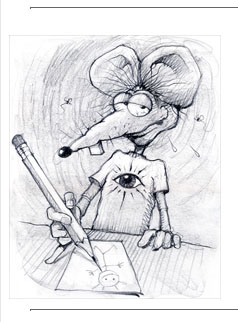
Thanks for writing in, Stanley. - Bob A Leica M3 from that era (from Wikipedia). Leica M3's were issued between 1954 and 1967. 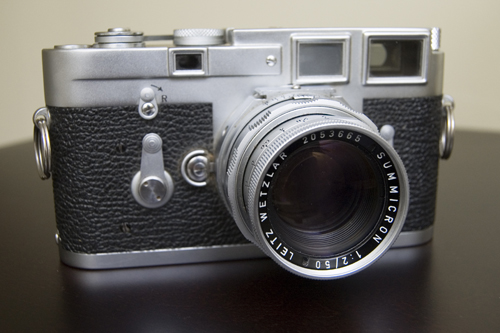
ADDENDUM #3 Some typos I have changed: Rob Weir to Bob Weir; Jim Kreutzman to Bill Kreutzmann; also the album was released in 1970, I had written 1971 and 1968 at one point.
ADDENDUM #4 Tom B. wrote in to say that the new photo of the Dead in front of Beanie's can be found in the 12-CD box set called "The Golden Road (1965-1973)" released in 2001 by Rhino Records. ADDENDUM #5 Several people have written to say that there is a brewery/bar called "Speakeasys Ales & Liquors ("Speakeasy's") now located at the site of Beanie's Place tavern ("Speakeasy's" is officially at 1195 Evans Avenue) . And Speakeasy's later referred to the PopSpots entry on its webpage: A photo of Speakeasy's from "Brewed for Thought." 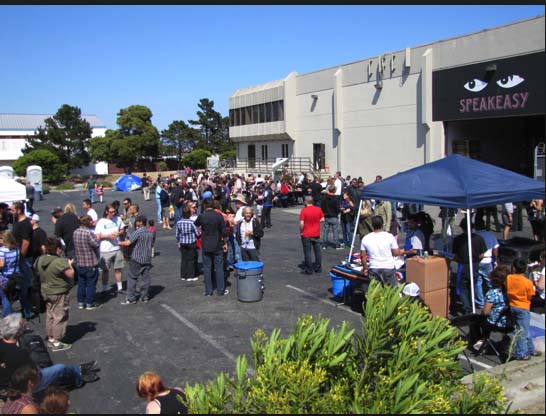
Item from Speakeasy's Facebook page: 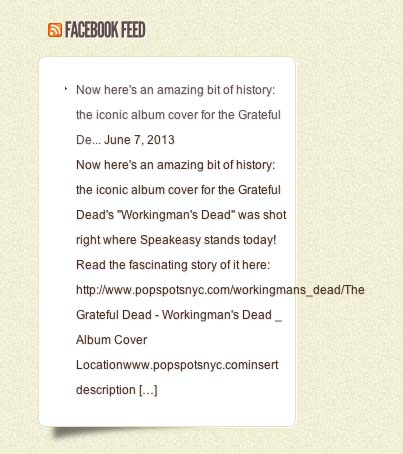
The photoshoot would have been near the corner of the parking lot. 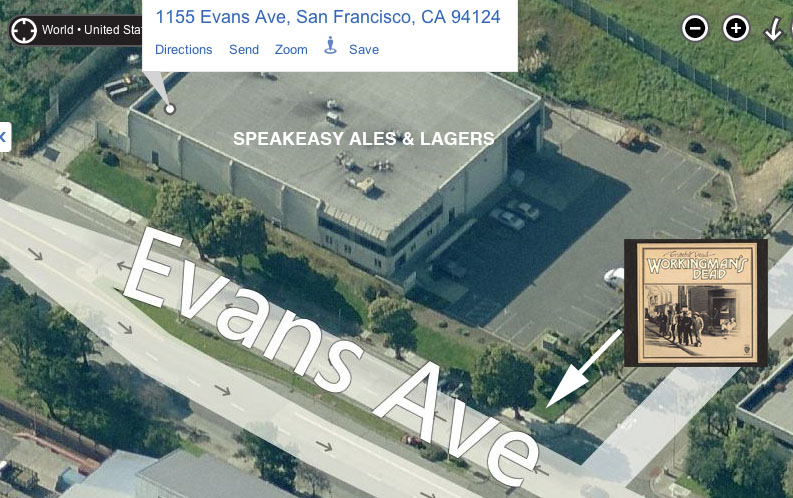
ADDENDUM #6 You can read what other people are writing about the Workingman's Dead entry at these forums: ADDENDUM #6 A reader named IHOR tweaked the color of the photos on the roof. It would take me a lot of time to switch them with mine, but I will display them all here, as you can see different things in the new colors than the older shots I found oniine: 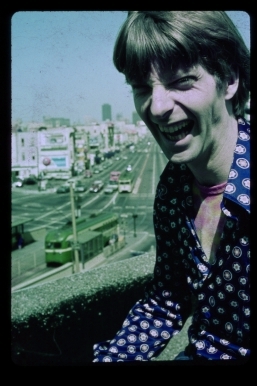

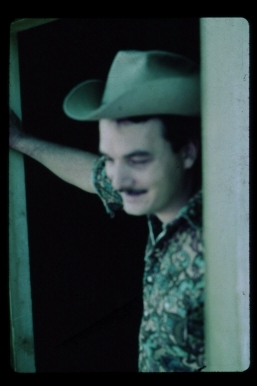
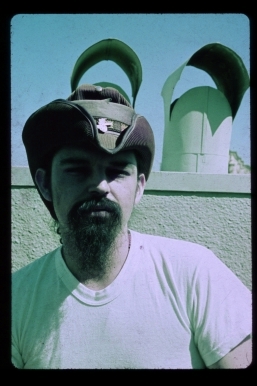
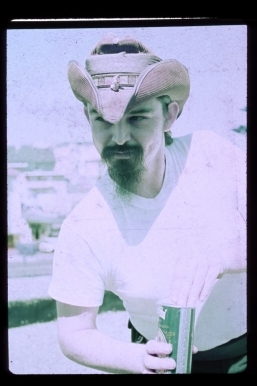
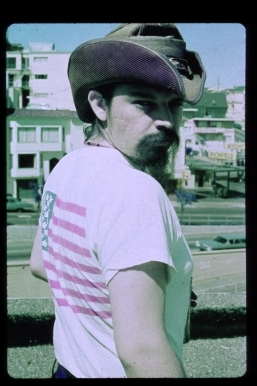
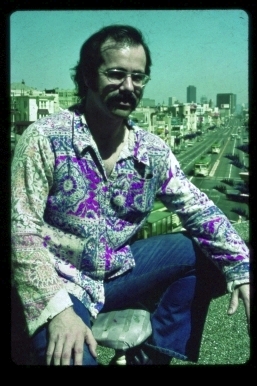

Ihor also brought something else to my attention. On the back cover of the album Jerry is shown with five fingers on his right hand (see below). As most Dead afficianades know, Jerry lost his middle right finger in childhood. So what's the explanation? 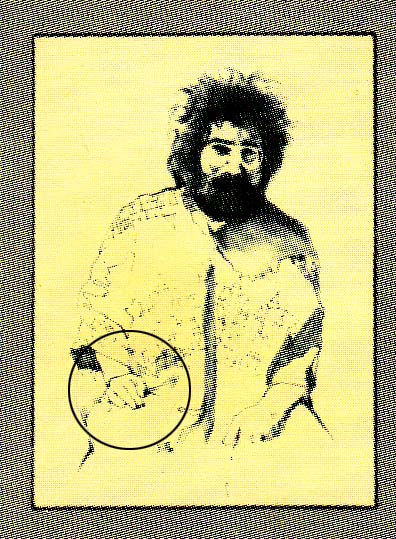
As an answer, Ihor also sent this photo. A 1970 publicity shot of the Dead sitting on bales of hay. In it, Jerry is dressed almost exactly (if not exactly) as he is on the back cover. 
If you flip the back cover shot horizontally, you see the pictures are similar, probably from the same photo session. Thus, it is really Jerry's right middle finger that is missing, it's the back cover drawing that was flipped. 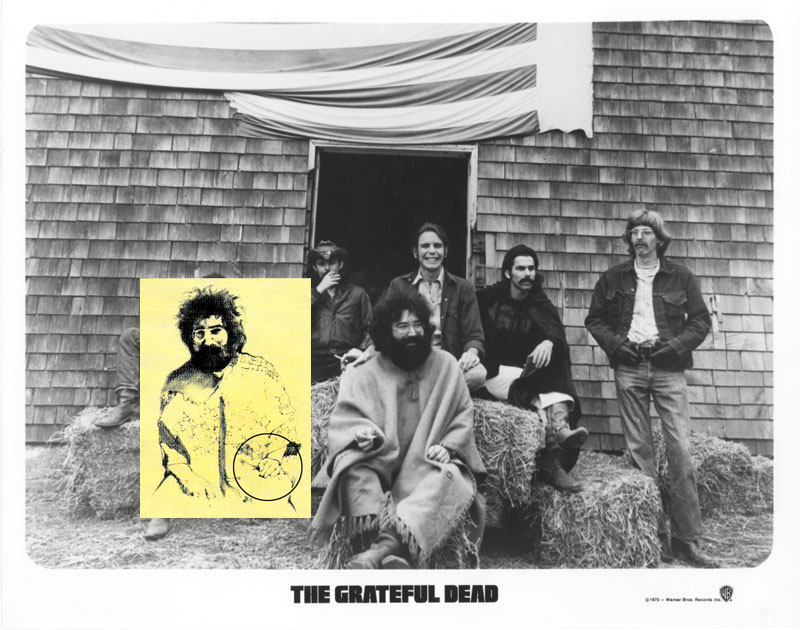
Stanley Mouse adds an explanation via an email, in which he also discusses the photoshoot. >>They were projected photos that i traced up with a pencil then freehand >>airbrushed it with ink on newsprint paper. >> I was living in an attic of a beautiful green mansion next to the b of a just >> off the corner of mkt and castro that was rented by the comedy group The >> congress of wonders. They were going to use it to film a movie called >> marijuana hell. It was always empty. The attic was all redwood and had a >> balcony where you could see right down mkt st to the ferry bldg. i >> photographed the band there. In my marijuana stupor, i left robert hunter out >> of the portraits. Something i regret to this day. The movie was never made and >> sometime later the mansion was tore down. A pity >> Toon was martin gorak a great artist and magician from detroit. Went by >> martoon master of the mystic poobah. >> T or tree was robert tree. We were all plotting this fiasco. Had a lot of >> laughs. >> Kelley had nothing to do with it. He was in boston. >> Stanley >> Mouse studios ADDENDUM #7 Pictured below is the mansion Stanley Mouse was partially renting when he took the pictures of the Dead on the roof deck, which is the square in the center of the circle. You can see the peak of the roof below it under which Jerry Garcia was photographed in the attic. 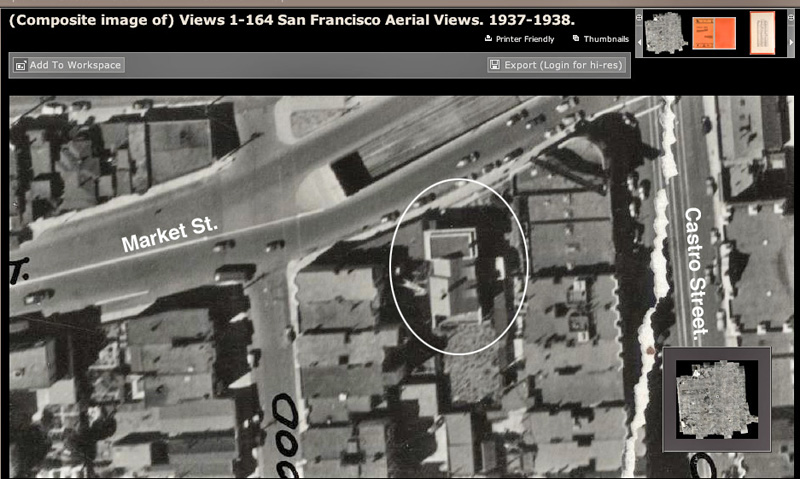
Circled below is the building that replaced the mansion. 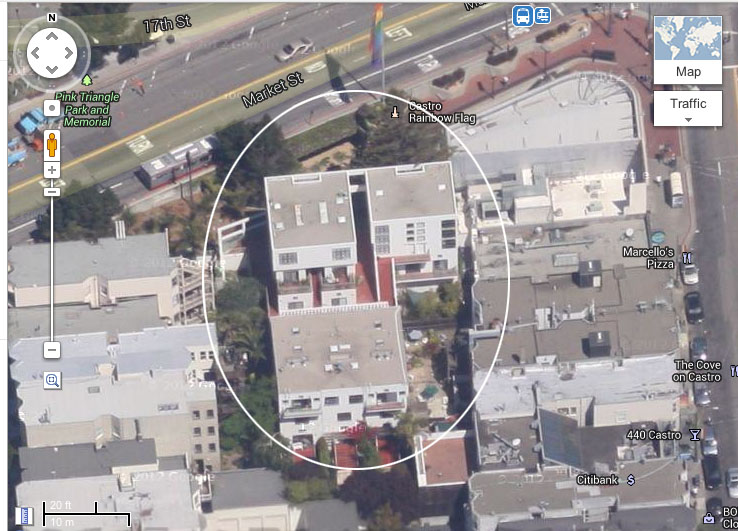
This is the first of two photos, found by Jonathan Lammers, of the house from a side view. This picture was taken in 1922 and comes from the San Francisco Public Library. 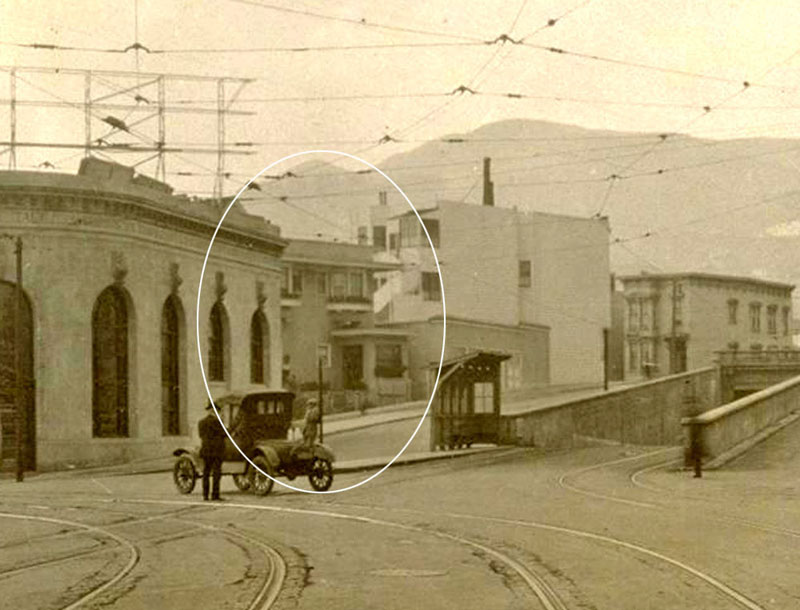
Here's another side view of the deck, via Jonathan Lammers and the SFPL. 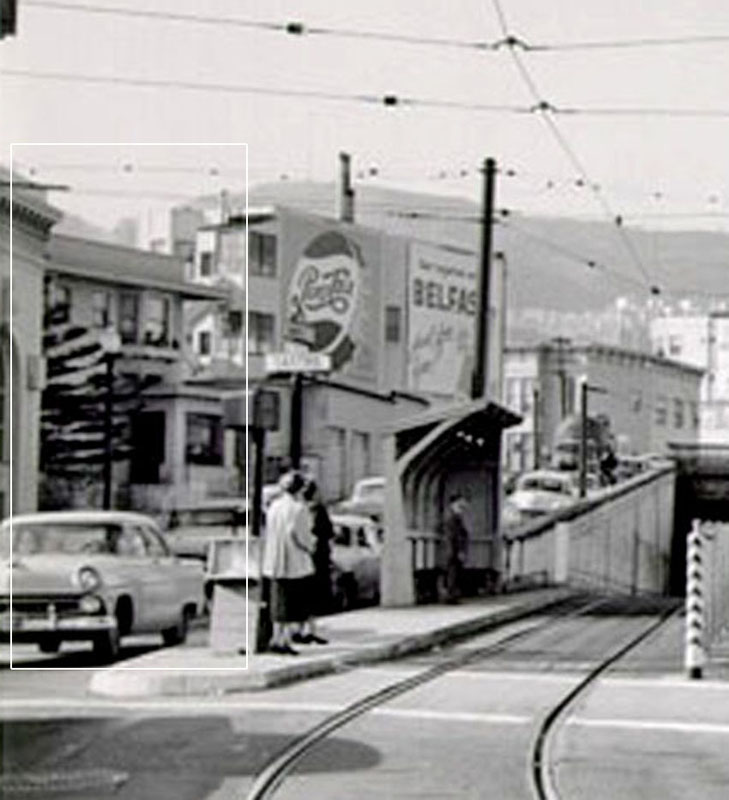
ADDENDUM #7 - FOUR GRATEFUL DAD POPSPOTS from POPSPOTS/FACEBOOK The Dead performing free on a flatbed truck on Haight Street, March 3, 1968. Photo by Jim Marshall. 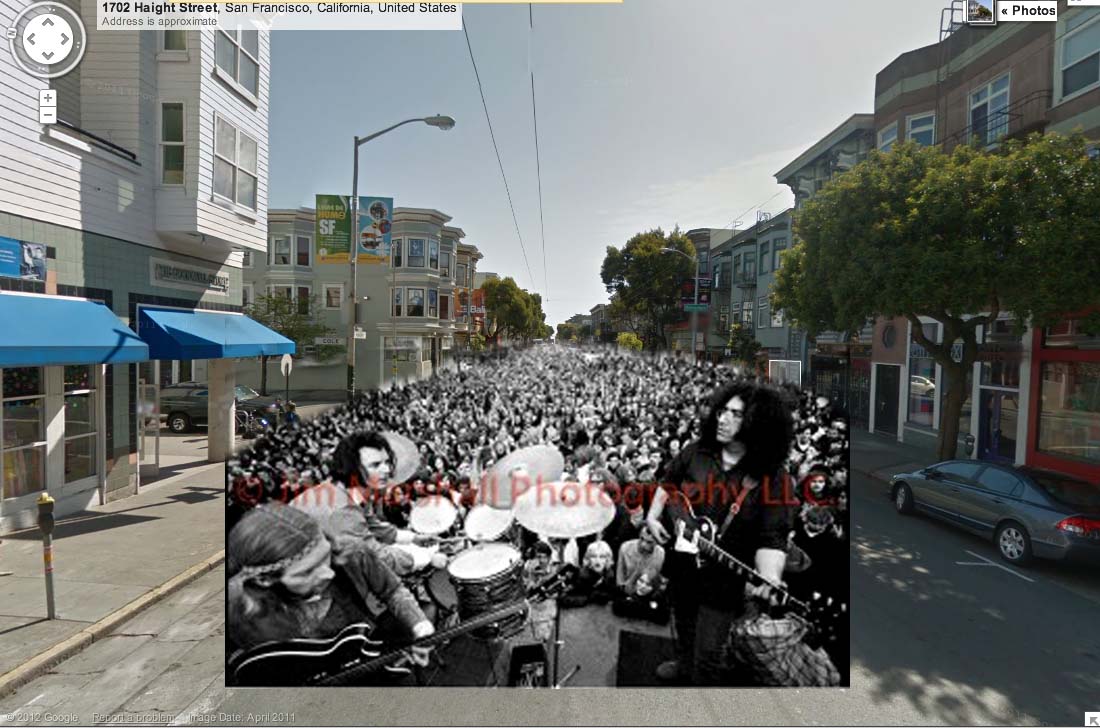
The Dead at the intersection of Haight and Ashbury Street in 1967. Dead photo by Herb Green. .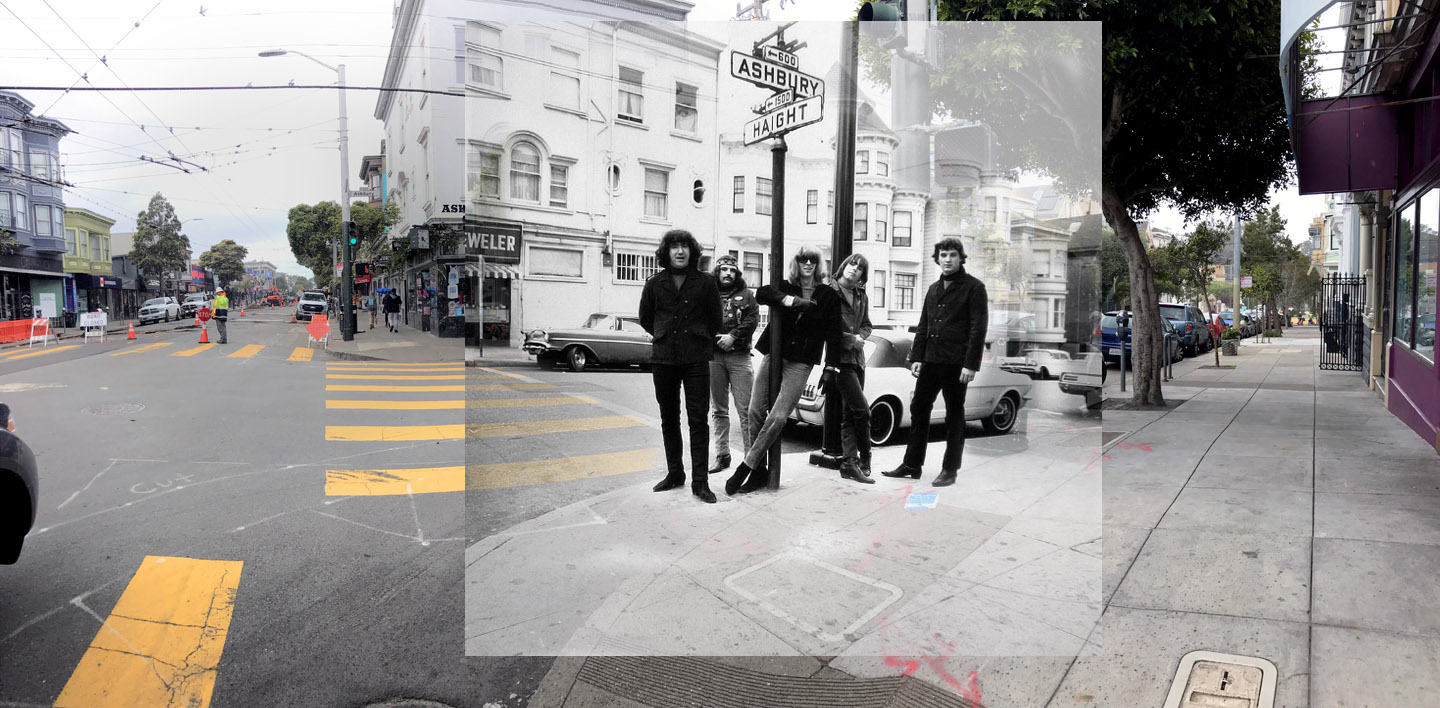
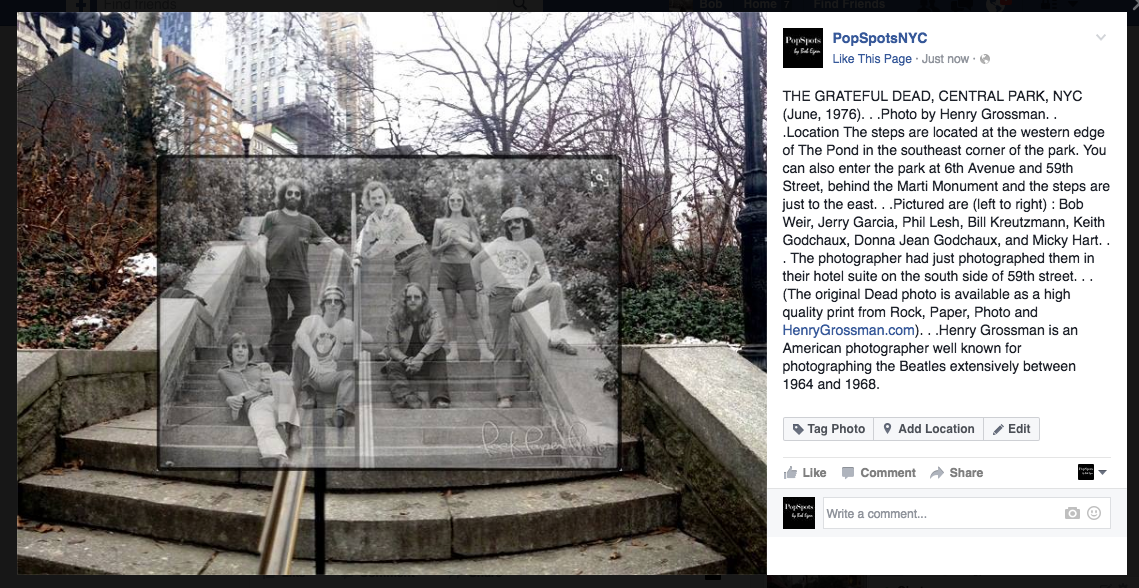
The Dead playing at the Central Park Bandshell on May 5, 1968 in a free concert along with The Jefferson Airplane and the Paul Butterfield Blues Band. 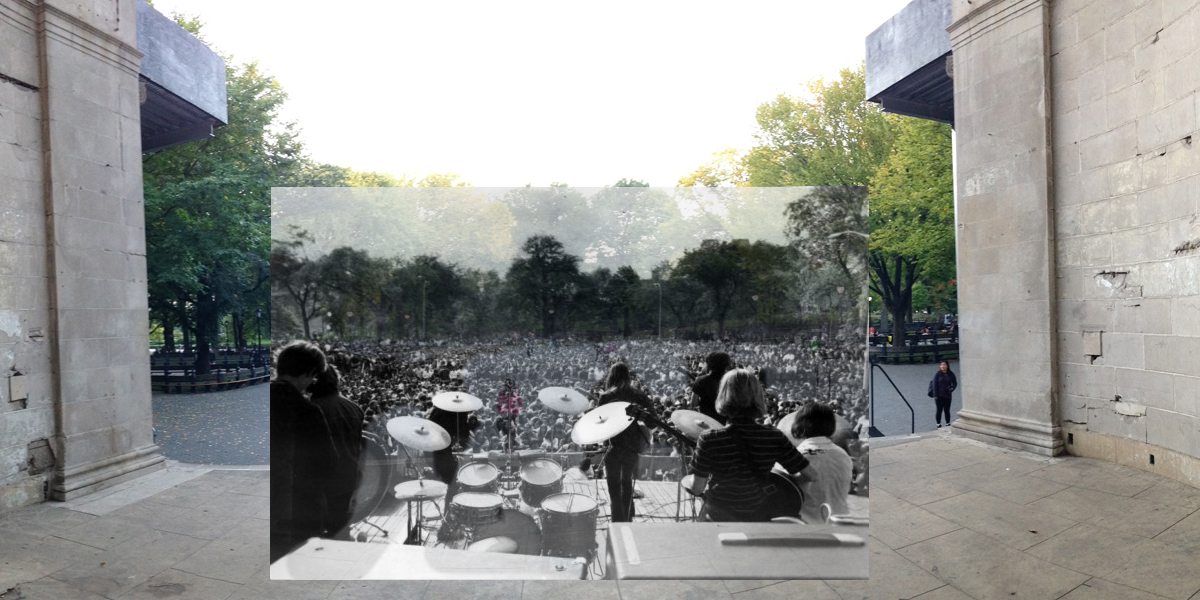
|
|||

